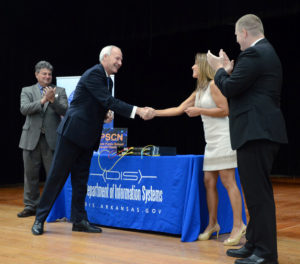
By Steve Brawner
It’s not often a public policy problem can be completely checked off the to-do list. Last month, one was.
That’s when 100 percent of Arkansas’ school districts reached broadband internet connections of 200 kilobits per second per student. That’s twice the national standard, at no more cost than the previous slower speeds. According to the group Education Superhighway, only five states had reached the 100 kbps standard as of 2016, though others may do so along with Arkansas this year.
Gov. Asa Hutchinson marked the occasion July 21 in Glen Rose, a small school district between Benton and Malvern. It had been one of the state’s last districts to obtain its high-speed fiber connection the previous week.
A remarkable turnaround
The milestone is a remarkable turnaround for a state that until recently was making headlines for being behind the times. The Foundation for Excellence in Education slapped Arkansas with a “D” in its 2013 “Digital Learning Now” report. A 2014 study found the state had spent almost $160 million with vendors on the Arkansas Public School Computer Network since 1992. But instead of investing in high-speed options like fiber, it was spending 70 percent of the budget on antiquated copper wiring, delivering information at a measly 5 kbps. By supplementing APSCN with private providers, 58 percent of Arkansas districts were meeting the 100 kbps standard. However, 17 percent offered speeds of only 10-49 kbps, while 5 percent were even slower.
The problem snuck up on policymakers but was exposed when the state started adopting the Common Core curriculum. Then there was a big, very political argument about schools hooking up to the universities’ and hospitals’ network.
Under Hutchinson, state a leader in coding movement
That’s all in the rear-view mirror now, and much of the credit belongs to Hutchinson. The 66-year-old has been a forward-thinking leader regarding public school technology. Most notably, he kept a campaign promise that Arkansas would become the first state to require high schools to teach computer coding. As a result, the number of students taking those classes has increased from 691 to 5,500. A story by the influential Wired magazine was headlined, “So, Arkansas is leading the learn to code movement.”
But computer coding skills don’t mean much without modern internet connections. After becoming governor in 2015, Hutchinson ordered the creation of a statewide broadband network and placed it under the supervision of the Department of Information Systems. Previously, DIS shared responsibility with the Department of Education. Those changes improved the state’s negotiating position with the Federal Communications Commission for its E-rate program, which is paying about 79 percent of the costs. Meanwhile, the state negotiated rates with private vendors, some of which waived their fees.
As a result of all of this, the state will provide the 200 kbps for about $13-$14 million annually, or about the same amount it was spending before. It’s up to the individual districts to build out their networks from their hubs to their outlying schools. That’s not expected to be a problem, and they can choose to spend more for higher speeds. Now, internet access will not be a barrier whether students are in Glen Rose, Fort Smith, Jonesboro or Pine Bluff.
What now?
But what do educators and students do with that access? Everyone with a broadband connection or a smartphone knows high-speed internet is both an awesome tool and an awful distraction. It can make us more connected, but also less so, and more powerful but also more passive. An inspired teacher with a history book and a chalkboard can impart more knowledge than a poor one with a blazing fast internet connection.
Still, while tools don’t assure success, they help more than they hurt. So now Arkansas students, so often in the past disadvantaged compared to their peers, have this one on their side: Their internet access is as good as anyone’s in the country and better than many, regardless of where in the state they call home.
That’s not bad for a state that was falling behind the times not long ago, and was stuck in a very political argument about what to do about it.
© 2017 by Steve Brawner Communications, Inc.